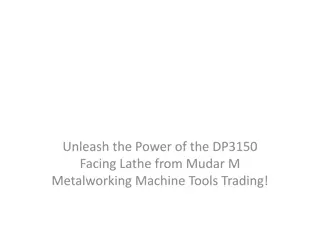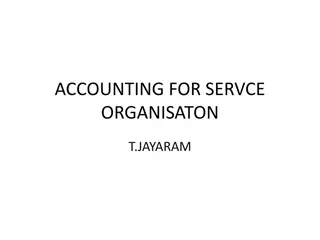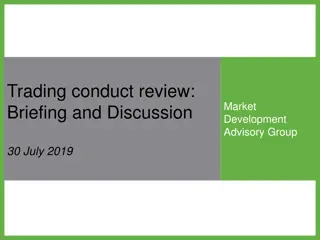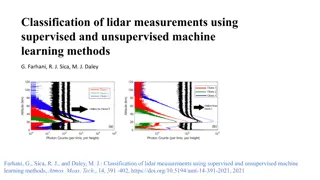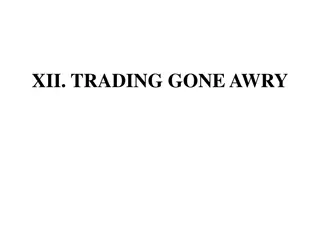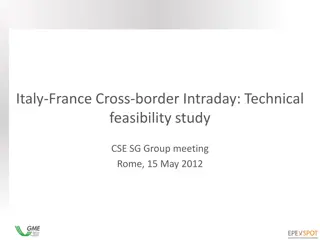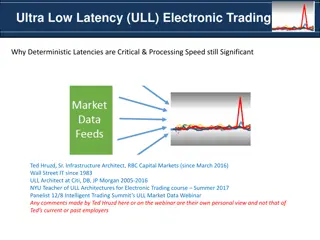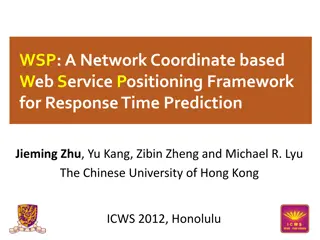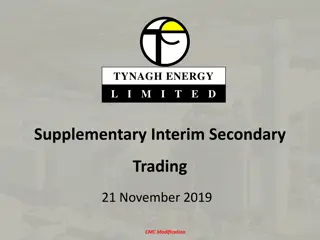Machine Learning Framework for Algo Trading in Limit Order Book Prediction
Explore the use of machine learning algorithms for predicting market trends in a limit order book setting. Financial exchanges rely on transparent systems like the Limit Order Book to match buy and sell orders efficiently. Researchers have delved into using deep learning and statistical methods to forecast price movements based on order book data. The proposed system aims to design a framework that leverages machine learning to enhance predictive capabilities in algorithmic trading within the financial markets.
Download Presentation

Please find below an Image/Link to download the presentation.
The content on the website is provided AS IS for your information and personal use only. It may not be sold, licensed, or shared on other websites without obtaining consent from the author. Download presentation by click this link. If you encounter any issues during the download, it is possible that the publisher has removed the file from their server.
E N D
Presentation Transcript
Algo trading in a limit order book prediction using Machine Learning Algorithm Ahlia University 7th Annual Research Forum Dr. Suresh Subramanian College of Information Technology
Agenda Introduction Literature review Problem statement Objectives Proposed System Design Proposed System Sample Data Representation Conclusion 2
Introduction Financial Exchanges Exchanges are organized marketplaces where securities (like stocks), commodities and derivatives (among other financial instruments) are traded Investors need to agree upon a price before exchanging an asset, and this needs to be done centrally so the transactions can be monitored Exchanges use what is called a Limit Order Book to achieve this coordination 3
Introduction Limit Order Book (LOB) The Limit Order Book is a transparent trading system that matches customer orders price first time second priority basis (bids and asks) using a When an order is submitted it contains 3 attributes: Whether it is an ask (sell) or bid (buy) order The price limit p(t) The size of the order v(t) The order book has two sides, the bid side, containing buy orders, and the ask side, containing sell orders 4
Literature Review [1] Huang, B., Huan, Y., Xu, L. D., Zheng, L., & Zou, Z. (2019). Automated trading systems statistical and machine learning methods and hardware implementation: a survey. Enterprise Information Systems, 13(1), 132-144. [2] Tsantekidis, A., Passalis, N., Tefas, A., Kanniainen, J., Gabbouj, M., & Iosifidis, A. (2018). Using Deep Learning for price prediction by exploiting stationary limit order book features. arXiv preprint arXiv:1810.09965. [3] Chen, S., & He, H. (2018, October). Stock Prediction Using Convolutional Neural Network. In IOP Conference Series: Materials Science and Engineering (Vol. 435, No. 1, p. 012026). IOP Publishing. [4] Tsantekidis, A., Passalis, N., Tefas, A., Kanniainen, J., Gabbouj, M., & Iosifidis, A. (2017, July). Forecasting stock prices from the limit order book using convolutional neural networks. In 2017 IEEE 19th Conference on Business Informatics (CBI) (Vol. 1, pp. 7-12). IEEE. [5] Box, G. E., Jenkins, G. M., Reinsel, G. C., & Ljung, G. M. (2015). Time series analysis: forecasting and control. John Wiley & Sons. [6] Cartea, ., & Penalva, J. (2012). Where is the value in high frequency trading?. The Quarterly Journal of Finance, 2(03), 1250014. [7] Avellaneda, M. (2011). Algorithmic and High-frequency trading: an overview. In New York University & Finance Concepts LLC Quant Congress USA 2011. 5
Problem Statement Propose a machine learning framework to capture the dynamics of high frequency limit order books in financial equity markets and automate real-time prediction of metrics such as mid-price movement and price spread crossing. Why Algo Bahrain? http://algobahrain.com/#WhyALGOBahrain? Algorithmic trading is the concept has introduced in Bahrain in 2017 to interconnect the banks through FinTech technology Four out of ten customers in the GCC are ready to switch to a digital-first relationship (http://www.bizbahrain.com/algo-bahrain-worlds-first-fintech-consortium-islamic- banks/). 6
Objectives To accomplish the prediction of price movements based on current and past changes occurring in the limit order books To propose a machine learning framework to capture the dynamics of high frequency limit order books in financial equity markets and automate real-time prediction of metrics such as mid-price movement. To analyse and evaluate the accuracy of the proposed system using deep learning techniques. To benchmark with other standard techniques such as Support Vector Machine (SVM) and Regression analysis. 7
Proposed system Proposed system has the following steps Get the Data Open Dataset First publicly available datasets that contain representations and annotations for a limit order book (LOB) in the High Frequency Trading universe. Benchmark Dataset for Mid-Price Forecasting of Limit Order Book Data with Machine Learning Methods. Paid Dataset NASDAQ datasets Generate Features Auto Regressive Integrated Moving Average (ARIMA) model is proposed which is the most popular in time series analysis [4] Statistical checks Ensuring that the data has good quality is very important for our models. Proposed techniques are Conditional Heteroskedasticity, serial correlation 9
Proposed system Generate Model Deep Learning techniques are identified Convolutional Neural Networks (CNN) [3] Recurrent Neural Network (RNN) [2][5] Train the model Test the model Predict the Accuracy Benchmarking with standard model Implementation Python V 3.6 TensorFlow 10
Data Representation Sample data of Limit Order Book Adopted from [4] 11
Data Representation Adopted from [4] 12
Data Representation Adopted from [4] 13
Data Representation Adopted from [4] 14
Conclusion Proposed work is the Inter-disciplinary work which includes IT and Finance Suggestions from QS Maple presentation at Ahlia University by Mr. Ashwin Why Algo Bahrain? Proposed work is submitted to Contribution Committee (ARICC) Ahlia University - Academic Research Intellectual Application for funding to conduct a research (Submitted the application to ARICC) project Primary Investigator : Dr. Suresh Subramanian Co-Investigator: Dr. Gagan Kukreja Received the positive feedback from reviewers and comments are addressed in this presentation 15
Conclusion Thank You Any Questions Please ? 16


![Guardians of Collection Enhancing Your Trading Card Experience with the Explorer Sleeve Bundle [4-pack]](/thumb/3698/guardians-of-collection-enhancing-your-trading-card-experience-with-the-explorer-sleeve-bundle-4-pack.jpg)

